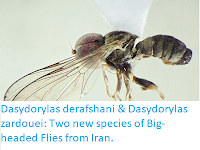Hoverflies, Syrphidae, are one of the most successful groups of True Flies, Diptera, alive today, found on all landmasses except Antarctica, Spitzbergen and some remote oceanic islands. They play a significant ecological role, both as adult pollinators and as voracious predators during their larval stages, and are thought to have appeared during the Middle Cretaceous, around the time when Angiosperms (Flowering Plants) were rapidly diversifying and coming to dominate most terrestrial ecosystems. Despite this success, the fossil record of Hoverflies is rather sparse, with only 106 fossil species described, the most recent of which was identified in 2005.
In a paper published in the journal Acta Palaeontologica Polonica on 20 July 2018, Valentin Nidergas of the Institut Systématique Evolution Biodiversité at the Muséum national d’Histoire naturelle, Jiří Hadrava of the Department of Zoology at Charles University, Romain Garrouste, also of the Institut Systématique Evolution Biodiversité at the Muséum national d’Histoire naturelle, Jakub Prokop, also of the Department of Zoology at Charles University, and Thomas Schubnel and André Nel, again of the Institut Systématique Evolution Biodiversité at the Muséum national d’Histoire naturelle, describe a new species of Hoverfly from the Middle Oligocene clay-limestone laminites of the National Geological Reserve of Lubéron at Cereste in France.
The new species is named Oligopipiza quadriguttata, where ‘Oligopipiza’ derives from ‘Oligocene’ and ‘Pipiza’ a modern genus which the new Hoverfly resembles, and ‘quadriguttata’ means ‘four drops’ in reference to the markings on the abdomen of this species. Oligopipiza quadriguttata is named from four male and four female specimens, obtained by splitting the laminites with a hammer and a spatula. These specimens are 6.8-8.1 mm in length, with hairy abdomens, thoraxes and legs, with two pairs of yellow, drop-shaped markings on the abdomens; these vary in size but are always present.
Pipizine hoverfly Oligopipiza quadriguttata, male. Rupelian, Céreste, France. Nidergas et al. (2018).
Many of the specimens assigned to the species were covered in what appeared to be Pine pollen. This is surprising, as while modern Hoverfly’s are significant pollinators, no there are no recorded instances of modern Pines being pollinated by Hoverflies, or indeed any other Insect, the group being entirely wind-pollinated today. However, the Lubéron deposits are thought to have been laid down in a mixed Pine/broadleaf forest, a similar habitat to that occupied by many European Pipizine Hoverflies today, with macrofossils of Pine fragments being quite common, but no previously recorded Pine pollen. This is curious, as (wind-pollinated) Pines usually produce copious amounts of pollen, which is likely to be preserved in any local deposits preserving other fossils. The presence of a Pine species reliant on Insect pollination might help to explain this, as such as species could produce far less pollen, and would not need to shed it so freely into the environment.
See also...
Follow Sciency Thoughts on Facebook.







